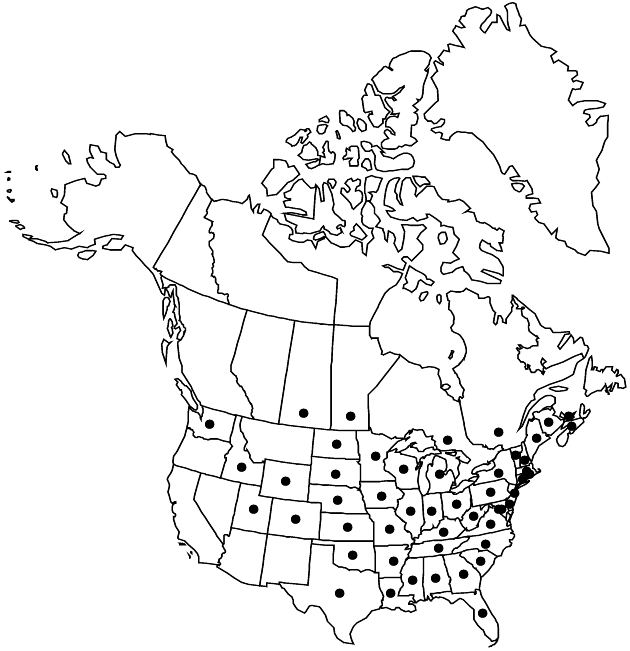Helianthus tuberosus
Sp. Pl. 2: 905. 1753.
Perennials, 50–200+ cm (rhizomatous, producing tubers late in growing season). Stems erect, scabro-hispid to hirsute (sometimes glaucous). Leaves mostly cauline; opposite or alternate proximally, usually alternate distally; petioles 2–8 cm (often ± winged); blades (3-nerved from near bases) lanceolate to ovate, 10–23 × 7–15 cm, bases broadly to narrowly cuneate, margins entire or serrate (flat), abaxial faces puberulent or hirsutulous to tomentulose and glanddotted (abaxial) or ± scabrous (adaxial). Heads 3–15. Peduncles 1–15 cm. Involucres hemispheric, (10–25 ×) 8–12 mm. Phyllaries (often dark green, drying nearly black) 22–35 (bases appressed, apices ± spreading, sometimes reflexed in fruit), lanceolate, 8.5–15 × 2–4 mm (subequal), (margins ciliate) apices acuminate, abaxial faces hispidulous or puberulent, glanddotted. Paleae 8–9 mm, 3-toothed (apices hairy). Ray-florets 10–20; laminae 25–40 mm. Disc-florets 60+; corollas 6–7 mm, lobes yellow; anthers dark-brown or black, appendages dark or yellowish. Cypselae 5–7 mm, glabrous or distally hairy; pappi of 2 aristate scales 1.9–3 mm plus 0–1 deltate scales 0.5–0.8 mm. 2n = 102.
Phenology: Flowering late summer–fall.
Habitat: Roadsides, fields, waste areas
Elevation: 0–1000(–1500) m
Distribution

Man., N.B., N.S., Ont., P.E.I., Que., Sask., Ala., Ark., Colo., Conn., Del., D.C., Fla., Ga., Idaho, Ill., Ind., Iowa, Kans., Ky., La., Maine, Md., Mass., Mich., Minn., Miss., Mo., Nebr., N.H., N.J., N.Y., N.C., N.Dak., Ohio, Okla., Pa., R.I., S.C., S.Dak., Tenn., Tex., Utah, Vt., Va., Wash., W.Va., Wis., Wyo., cultivated and adventive in Europe
Discussion
Helianthus tuberosus is variable, probably in part stemming from hybridization with other polyploids, including H. pauciflorus, H. resinosus, and H. strumosus. Helianthus tuberosus is so widely spread as a weedy species that its original distribution is difficult to discern. It has been used as a food plant for its tubers by native Americans (although not necessarily domesticated or even cultivated); it has been developed as a crop primarily in Europe, where it has become widely naturalized. The common name Jerusalem artichoke is a misnomer, as explained by C. B. Heiser (1976).
Selected References
None.
Lower Taxa
"[" is not declared as a valid unit of measurement for this property."]" is not declared as a valid unit of measurement for this property.